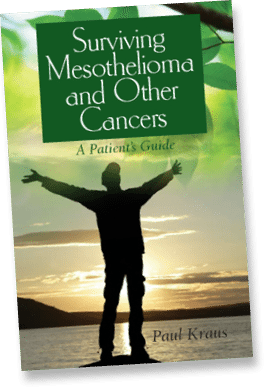Looking for mesothelioma information? The following section provides extensive information about mesothelioma, including symptoms, treatment, and more. Click on an item in the menu below to jump to that topic:
What is Mesothelioma?
Mesothelioma is a rare form of cancer. It comes from cells of the mesothelium that covers many internal organs. There are about 2,000 cases of mesothelioma diagnosed in the United States each year. Mesothelioma comes from exposure to asbestos. Asbestos is a cancer causing material used in many different kinds of products. Many companies kept using it even after they knew that it was dangerous.
Although rare, mesothelioma cancer is not a death sentence. The longest-living mesothelioma survivor in the world wrote a free book about it.
Where Does Mesothelioma Come From?
Mesothelioma is a rare form of cancer. It is sometimes called asbestos cancer. It comes from cells of the mesothelium, the lining that covers many of the internal organs.
Mesothelium
The main purpose of the mesothelium is to make the fluid between tissues and organs. This fluid provides a slippery and protective surface to allow movement.
The fluid allows the lungs to expand and contract inside the body each time you take a breath. When the cells of the mesothelium turn cancerous they become mesothelioma. That is where the name comes from.
Statistics
Mesothelioma is a rare disease. There are only approximately 2,000 cases diagnosed in the United States every year. Many more cases occur around the world. It is most common in Australia and the U.K. where they used large amounts of asbestos.
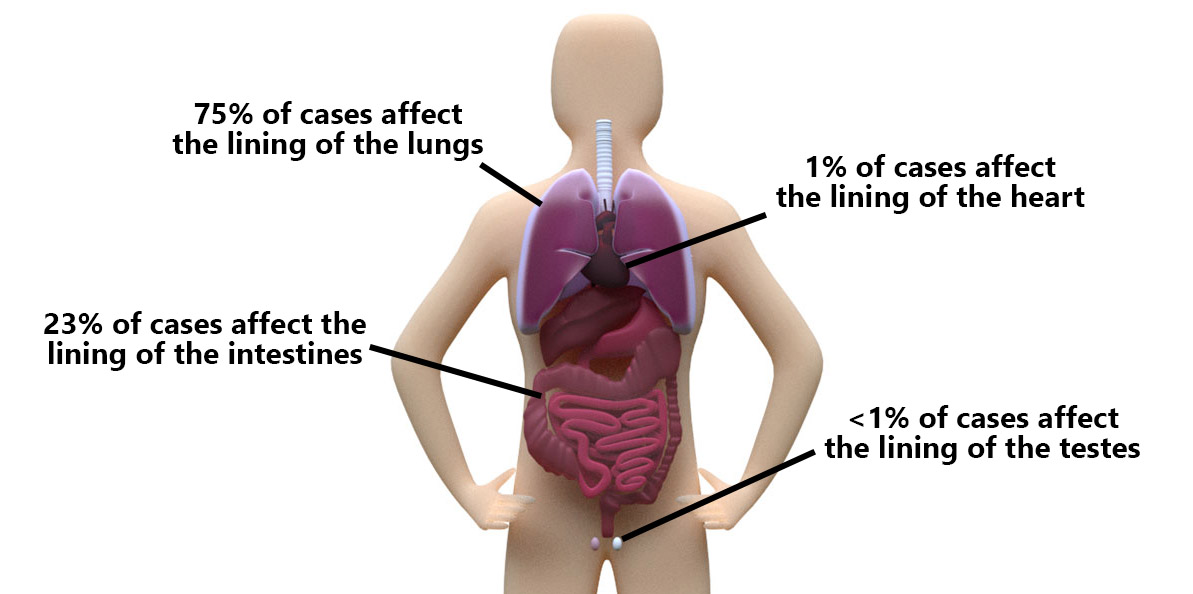
Mesothelioma Statistics in the U.S.
- 2,000 cases diagnosed every year
- 80% diagnosed are men
- 12 months median survival time
- 125 million have been exposed
In Other Countries
Number of cases per year in other countries:
| Australia | 661 |
| United Kingdom | 2,560 |
| Germany | 1,900 |
| Japan | 1,068 |
Types of Mesothelioma
There are four types of malignant mesothelioma: Pleural, peritoneal, pericardial and testicular. Pleural mesothelioma affects the outer lining of the lungs and chest wall. It represents about 75% of all cases. Peritoneal mesothelioma affects the abdomen and represents about 23%. Incidences of cases in the lining of the testis and the heart represent about 1% each.
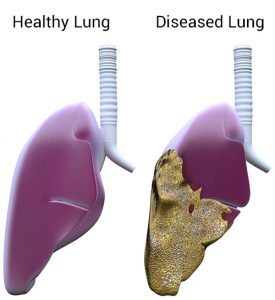
Pleural Mesothelioma
When then pleural lining around the lungs and chest wall are involved in this cancer it is called pleural mesothelioma. There are actually two layers of tissue that comprise the pleural lining. The outer layer, the parietal pleura, lines the entire inside of the chest cavity. The inner layer is called the visceral pleura and it covers the lungs.
Mesothelioma usually affects both layers of the pleura. Often it forms in one layer of the pleura and invades the other layer. The cancer may form many small tumors throughout this tissue.
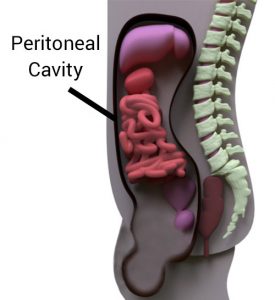
Peritoneal Mesothelioma
When the peritoneum, the protective membrane that surrounds the abdomen is involved in this cancer it is called peritoneal mesothelioma. Just like pleural mesothelioma, there are two layers of tissues involved with the peritoneum, the parietal layer covers the abdominal cavity, while the visceral layer surrounds the stomach, liver and other organs.
The cancer often forms many small tumors throughout the tissue. One doctor has described it as if someone took a pepper shaker and scattered the pepper over the tissue.
Cell Types
In addition to the different types of locations within the body, there are also different cell types. These types are all considered mesothelioma, but they can affect the patient’s prognosis.
The three mesothelioma cell types are: epithelioid, sarcomatoid and biphasic.
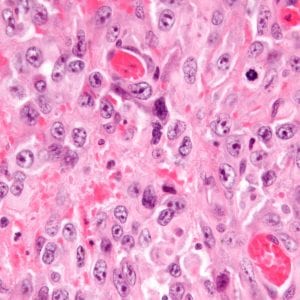
Epithelioid Cells
Epithelioid mesothelioma cells are the most common type of mesothelioma cell and has the best prognosis of the three cell types. Notice the dark purple, elongated egg shaped cells amongst the healthy pink colored tissue.
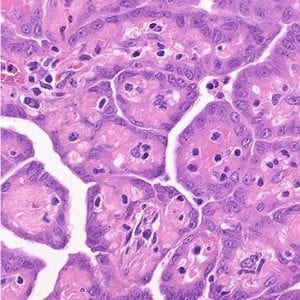
Sarcomatoid Cells
Sarcomatoid mesothelioma cells are the rarest of the three cell types and tends to be more aggressive than epitheloid cells. Notice the dark purple nodules amongst the healthy light purple colored tissue.

Biphasic Cells
Biphasic mesothelioma cells are mixtures of both cell types (epithelioid and sacromatoid) and usually has a prognosis that reflects the dominant cell type.
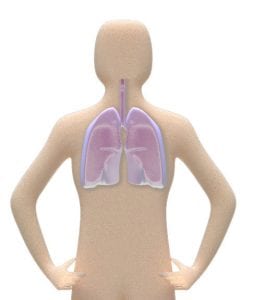
Signs & Symptoms
Symptoms of Pleural Mesothelioma
- Shortness of breath due to pleural effusion (accumulation of fluid between the lung and the chest wall)
- Chest pain
- Weight loss

Symptoms of Peritoneal Mesothelioma
- Abdominal pain and/or swelling
- Diarrhea or constipation
- Night sweats and/or fever
- Weight loss
- Nausea or vomiting
- Fatigue
Causes
What is the Cause of Mesothelioma?
Mesothelioma is caused by exposure to asbestos and it is therefore considered the asbestos caused cancer.
Asbestos has been in use since ancient times, but after the Industrial Revolution its use became widespread and was used all over the world in thousands of industrial and consumer products even after many companies knew that it was dangerous. Construction materials, automotive parts and household products such as hair dryers and oven mitts contained asbestos in the past.
Today, asbestos has been outlawed in most places around the world, however, asbestos has not been outlawed in the United States and is still found in millions of homes and public buildings, such as schools, offices and parking garages.
Survivor Stories
Discover the Secret Behind These Mesothelioma Survival Stories
Asbestos

What is Asbestos?
Asbestos is actually a naturally occurring mineral found throughout the world. It was called the “magic mineral” because it is resistant to heat and corrosion. Also, it is a fiber so it can be woven into other materials.
Asbestos is composed of millions of sharp microscopic fibers. These fibers are so small that the body has difficulty filtering them out. This means that if you around airborne asbestos you may inhale it or ingest it. This is known as asbestos exposure.
How Does Asbestos Cause Mesothelioma?
The actual process as to how asbestos causes mesothelioma is still being investigated. Most scientists believe that when the small sharp fibers are ingested or inhaled they cause cell damage which can cause chronic inflammation.
This inflammation can then set the stage for disease after many years or even decades. Some scientists believe that a person’s immune system may actually help prevent the cancer, even if that person is exposed to asbestos.
Asbestos Exposure
Since asbestos causes this rare disease, how to people get exposed to asbestos? While asbestos was in thousands of products, workers in some professions had more exposure to this carcinogen than others.
Examples of occupations that exposed workers to asbestos includes: Navy veterans, construction trades such as electricians, mechanics, and plumbers, people working in power houses and power plants, firefighters, and refinery workers. Individuals in these professions often had a multitude of asbestos containing products on their various job sites.
Most asbestos containing products were removed voluntarily by the late 1970’s. However, because there is no comprehensive ban on asbestos in the U.S. and because of the long latency period, people are still being diagnosed with mesothelioma today.
History of Asbestos

The history of asbestos in the United States and other industrialized countries is a sad story of corporate greed. Companies that produced asbestos containing products saw their workers becoming sick with lung scarring, asbestosis, and cancer nearly 100 years ago.
Some companies even brought in researchers and scientists to better understand the health impact of asbestos. Once it was shown that their “magic mineral” was toxic to human beings, the industry faced a dilemma.
Should they protect workers, warn consumers, notify public health officials, and most importantly, phase out this dangerous mineral? Their answer was “no.”
Instead industry did just the opposite. They warned no one, kept their knowledge about asbestos secret and continued to use it – for decades! Only by the 1960’s did independent researchers like Dr. Irving Selikoff of Mt. Sinai School of Medicine
begin to connect asbestos exposure to disease.
By then hundreds of thousands of men, women, and children were already exposed to this deadly mineral. The EPA would ban asbestos in 1989. However, the asbestos industry would sue the EPA and win.
In 1991 the ban was lifted. Even today, there is no comprehensive asbestos ban in the United States. Sad but true.
(Asbestos Medical and Legal Aspects by Barry Castleman)

Secondary Exposure, and the “Deadly Hug”
People exposed directly to asbestos are called “primary exposed.” Sometimes the person who is primary exposed will transfer asbestos fibers from their clothes to the clothes of another person. The person who gets this transfer of asbestos exposure is said to have “secondary exposure.”
One example of secondary exposure is called the “deadly hug.” Sadly, the deadly hug happens when an adult comes home from work with asbestos on their clothes and hugs their son or daughter, unknowingly transferring the dangerous fibers to their child. There have been many cases of adults being diagnosed with mesothelioma whose only exposure to asbestos came from their time as a child.
Latency
Time from Asbestos Exposure to Disease
There is a long latency period for mesothelioma which is the time from asbestos exposure to diagnosis of the cancer. This period can range anywhere from 20 to 50 years. There are different theories as to why there is such a long latency period and why most people exposed to asbestos do not get mesothelioma.
One theory suggests that there may be other variables that play a role. For example, some doctors believe that the condition or “competency” of a person’s immune system could determine whether asbestos in their body leads to cancer.
Other possibilities include a person’s genes and diet.
Diagnosis
When doctors suspect a patient has mesothelioma they will initiate a “work-up” in order to make a diagnosis. This work-up may include imaging scans, biopsies, pathology exams, blood tests and staging.
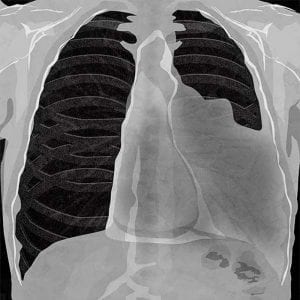
Imaging Scans
Various types of scans may be used to determine if there are signs of tumors or other abnormalities. These scans may include X-rays, CT scans, MRIs, or PET scans.

Biopsies
If scans reveal what doctors believe may be a cancer then a biopsy may be suggested. A biopsy is a procedure where doctors remove a small piece of the suspected tumor tissue from the patient’s body.

Blood Tests & Biomarkers
Blood tests and biomarkers may sometimes be used to determine if mesothelioma is present in the body. While these tests are helpful they are not considered as important as the biopsy which is considered the “gold standard.”

Pathology Exams
The biopsy material will then be given to a pathologist. A pathologist will use special stains and other tests to determine if there is cancer and identify exactly what type of cancer was removed from the patient.

Staging
If mesothelioma is diagnosed, doctors may stage the disease. Over the years a variety of staging systems have been used. The one used most frequently today groups the disease into localized (only in the mesothelium) or advanced (spread outside the mesothelium).
Prognosis
The prognosis of mesothelioma or any other cancer depends on a number of variables. Those variables include:
Type/stage of mesothelioma
- The type (pleural or peritoneal) and stage of the cancer (localized or advanced) play a role on prognosis. Some clinical studies suggest that peritoneal mesothelioma may have a better prognosis than pleural mesothelioma, with the appropriate treatment. A positive prognostic factor is also associated with cancer that has not metastasized. Cancer that is local and has not spread is obviously better.
Size and location of tumor
- Mesothelioma that is limited to the mesothelium and has not spread to lymph nodes or metastasized to other areas of the body can also indicate better prognosis.
Whether the cancer is operable or not
- Of all the conventional treatment (chemo, radiation or surgery), surgery has the greatest impact on prognosis. If a surgery can be performed this can often extend life. Therefore, whether a patient’s cancer is operable (which depends on the size and location) is another important prognostic factor.
Tumor cell type
- As discussed above, tumor cell type (epithelioid, sacromatoid and biphasic) plays a role in prognosis. The epitheloid cell type generally has the better prognosis.
Patient’s overall health
- A patient’s overall health also is important when discussing prognosis. The healthier a patient is can often determine what treatments are available and how well their body can withstand toxic therapies like chemo and radiation or recover from invasive surgery.
Doctor’s experience with the disease
- Patients often assume that all doctors are equally skilled with this rare disease. That is not true. For example, when it comes to surgery, multiple studies have shown that surgeons who have the most experience with mesothelioma often have better outcomes.
Treatment chosen
- Obviously the type and effectiveness (efficacy) of the treatment chosen plays a role on prognosis. Today, there are a variety of treatments and approaches available to patients.

Find a Doctor
A doctor specializing in mesothelioma can properly diagnose you and determine the best course of treatment. Find a mesothelioma specialist or doctor near you.
Treatments
The treatments for mesothelioma can be divided into three paths: Conventional Therapies, Clinical Trials, and Alternative Modalities.
Conventional Treatment
Conventional therapies include chemotherapy, radiation therapy and surgery. The standard chemo drugs used are Alimta (pemetrexed) and cisplatin (or carboplatin). They are often prescribed for the various types of mesothelioma, regardless of location. Both chemo and radiation therapy are known as cytotoxic or cell killing therapies. They work indiscriminately, killing both healthy and cancer cells. This is the reason that they can have severe side effects.
Surgery for Peritoneal Mesothelioma
The standard of care in many hospitals is to treat peritoneal mesothelioma with surgery and HIPEC. HIPEC stands for hyperthermic intraperitoneal perioperative chemotherapy which basically means flushing the surgical area with heated chemotherapy during the surgical procedure. The obvious advantage of this approach is that it enables doctors to put the chemo in exactly the place it needs to be.
Surgery for Pleural Mesothelioma
Of all the conventional treatments available, surgery is generally considered the most effective. For pleural mesothelioma, there are various types of surgical procedures, including lung sparring surgery (also called pleurectomy/decorticiaton or PD) and extrapleural pneumonectomy (also called EPP).
Pleurectomy / Decortications (PD)
Pleurectomy/decortication surgery is a two-part surgery that removes the lining surrounding one lung (pleurectomy), then removes any visible cancer seen growing inside the chest cavity (decortication). The advantage of P/D or lung sparring surgery is exactly what the name implies a lung is not removed.
Extrapleural Pneumonectomy (EPP)
An extrapleural pneumonectomy (EPP) is a much more invasive surgery than PD. An EPP involves removing a lung, the diaphragm, portions of the chest lining and heart lining, and nearby lymph nodes.
Numerous studies have been performed comparing the prognosis with a pleurectomy/decortications surgery versus an extrapleural pneumonectomy. While there is no consensus on the subject, the latest reports suggest that PD may be a better choice for many patients because survival is generally equivalent to EPP and PD is less invasive and therefore easier to tolerate.
Other Procedures
There are also other surgical procedures used to treat pleural effusion. Pleural effusion is the buildup of excess fluid in the pleural space between the visceral and parietal linings of the lungs. Examples of these procedures include pleurodesis and thoracentesis.
Clinical Trials
Clinical trials are treatments that are still being tested. These treatments may include chemotherapy or other more innovative approaches based on immune therapy, gene therapy or other biological approaches. One example of new treatments being tried in mesothelioma involve the use of monoclonal antibodies. Monoclonal antibodies are essentially an immune system therapy that tries to use antibodies to target cancer cells. The National Cancer Institute indexes clinical trials offered throughout the country.
Alternative Modalities
Alternative modalities include a large number of approaches such as intravenous vitamin therapy, herbs and Traditional Chinese Medicine, cannabis oil, dietary approaches, and mind-body medicine. It is important to note that while none of these modalities are FDA approved, there are a number of long-term mesothelioma survivors who have used them, including Paul Kraus.
Other Asbestos Related Diseases
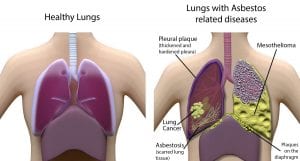
Mesothelioma is not the only disease caused by asbestos. Asbestosis which is essentially scarred lung tissue, pleural plaques and some lung cancers can also be caused by asbestos. There may also be compensation available to victims of these diseases as well. Treatments vary by condition.
Can A Better Diet Help With My Mesothelioma Treatment?

Factors such as multi-drug resistance, therapy related side effects, and disease recurrence after therapy have all been implicated as problems that prevent successful treatment of malignant mesothelioma. However, recent scientific evidence suggests that some common dietary phytochemicals, such as curcumin and quercetin, may have the ability to regulate microRNAs associated with malignant mesothelioma and possibly inhibit the cancer by regulating the expression of various genes which are known to be aberrant in malignant mesothelioma.
Curcumin
Curcumin is a natural occurring phytochemical found in turmeric, which is an Indian spice that gives curry powder its characteristic golden color. A study published by Jill M. Miller in Cancer Prevention Research suggest that curcumin can attach malignant mesothelioma cells in two ways. First, curcumin was able to induce pyroptosis, a highly inflammatory form of programmed cell death, in human malignant mesothelioma cells. In addition, curcumin was shown to protect against inflammation, which is a key mediator in the development of malignant mesothelioma and may be a key contributor to the dismal prognosis associated with the condition. Consequently, consumption of curcumin can offer a “two-pronged” attack against malignant mesothelioma by inducing pyroptosis in malignant mesothelioma cells as well as protecting against inflammation.
The Controlling Nutritional Status (CONUT) Score
Nutritional status may also play a role in mesothelioma prognosis. The Controlling Nutritional Status (CONUT) score was developed as a screening tool for early detection of poor nutritional status. A recent study published in a medical journal suggests that mesothelioma patients who were well nourished and had a CONUT score ≤ 2, had greater overall survival rates than those who were nutritionally challenged, CONUT score ≥ 3.
Everyday Eating
Treatments for mesothelioma can alter the appetite either because people are physically unable to eat properly due to the cancer or the treatment such as chemo, or because the taste of food is altered. Regardless, adequate nutrition is paramount for people with mesothelioma because patients often lose essential muscle and weight after diagnosis which can dramatically impact their prognosis. Consequently, eating a well-balanced diet can help people feel better when undergoing treatment for malignant mesothelioma.
Therefore, screening for nutritional status prior to treatment, consuming some dietary phytochemicals, as well as eating an overall well-balanced diet should help improve the outcome and overall state of well-being for patients undergoing treatment for malignant mesothelioma.
What Support is There for Families of Mesothelioma Sufferers?

Overall, receiving a cancer diagnosis can be difficult to deal with and comprehend. Receiving a diagnosis of mesothelioma can be overwhelming and, because of the rarity of the disease, can be difficult to find people who can sympathize and understand what it is like dealing with such an aggressive form of cancer. In addition, family members may be challenged with the task of becoming a caregiver for the first time. This can also be overwhelming. Consequently, people with mesothelioma as well as family members and caregivers of mesothelioma sufferers may need some help from time to time coping with their current situation. Luckily, there are many programs and support groups available to help decrease the stress associated with being a caregiver and to learn how to cope with this unfortunate situation.
Mesothelioma Support Groups
Support groups are a great resource for family members and caregivers of mesothelioma patients. There are a variety of formats that can allow you to choose a group that fits your specific needs. Many people enjoy online support groups because they can find the support they need any time of the day or night, it doesn’t’ require any specific time commitment, and they are able to connect with other mesothelioma patients, caregivers, and survivors from all over the world.
Many national cancer center organizations and some cancer centers offer a telephone support group. This option is similar to an online support group as it can allow patients and caregivers access to others in the same situation from other parts of the country and the world. Telephone support groups may also be a viable option if you cannot find a local support group that meets your needs or if you are unable to travel for planned support group sessions.
Counselors and Therapists
While some people feel comfortable sharing their experiences with others, some would prefer seeking a more private form of support. Having access to a certified counselor, therapist, or oncology social worker to share your feelings with may be a more comfortable and beneficial option than public forums.
Finding the right support group can be a challenge for many people. The majority of hospitals and medical centers offer their own support groups that you can join or at the very least have a list of local and national support group options for you to investigate. Having a conversation with the physician or social worker who is involved with the care of your loved one can be a great first step in find the support you need to get through this difficult time.
What Government Assistance is There for Mesothelioma Sufferers?

Receiving a diagnosis of mesothelioma can without a doubt be an emotionally overwhelming experience. While most people are focusing on their health and physical well-being, many do not realize the financial implications that are associated with this devastating diagnosis. Many people who are undergoing treatment for mesothelioma may require financial assistance to help cover the costs of living expenses, travel to and from specialists, and co-payments for treatments and medications.
Many individuals who are worrying about the financial hardship that may accompany a diagnosis of mesothelioma are unaware that several federal and federal assisted state agencies could possibly provide mesothelioma financial aid. This type of federal financial assistance is referred to as entitlement programs. Entitlement programs are in place for the sole purpose of providing assistance to low-income household, the elderly, and the disabled. However, the benefits offered by entitlements are not guaranteed and each program has eligibility requirements. To obtain benefits from these programs, mesothelioma patients will be required to submit proof of diagnosis, medical expenses, and income. There are several government agencies that can provide assistance during this difficult time.
Social Security Administration
People suffering from mesothelioma may qualify for mesothelioma financial aid through disability benefits provided by the Social Security Administration. In order to be eligible for these benefits, you cannot be retired and currently receiving retirement benefits through the Social Security Administration. In addition, you must have been previously employed and are now unable to maintain employment due to the diagnosis of mesothelioma.
Veterans Administration
Many individuals who have been diagnosed with mesothelioma have been exposed to asbestos while performing military service. The Veterans Administration has a program called the VA’s Disability Compensation program which is a tax-free benefit that is offered to veterans with disabilities that were a result of a disease or injury that occurred during their active military service. Veterans with a mesothelioma diagnosis may qualify for this benefit due to the disease being related to the circumstances associated with their military service.
The Health Resources and Services Administration’s (HRSA) Bureau of Primary Health Care
The HRSA Bureau of Primary Health Care provides Health Centers that provide health care to low-income and other vulnerable populations, including mesothelioma sufferers. These Centers provide primary and preventive health care as well as services such as transportation and translation.
Hill-Burton
Hill-Burton is a program through which hospitals receive federal money for various projects. Hospitals that receive Hill-Burton funds are required by law to provide services to people who do not have the resources to pay for their hospitalization and make their services available to all residents in the area of the facility. People with a diagnosis of mesothelioma may be able to seek care at facilities that receive Hill-Burton funds.
While this is not a complete list of services and programs that are provided by the Federal Government, it should provide enough information to eliminate some of the worry of the financial implications associated with a recent mesothelioma diagnosis. Receiving assistance from these programs will alleviate the stress and worry of finances and allow you to focus on your treatment and overall well-being. In addition, there is financial compensation available to most mesothelioma victims through trust funds and mesothelioma lawsuits.
Compensation for Mesothelioma Victims

Because asbestos causes mesothelioma and asbestos was put deliberately into products by manufacturers even after they knew it could cause disease, today there is compensation available to most victims. Examples of compensation may include workman’s compensation, VA benefits, bankruptcy trust funds, and lawsuits.
The most significant compensation can come from trust funds and lawsuits. The amount of compensation generally depends on four factors:
- How the patient was exposed to asbestos?
- Did those companies declare bankruptcy or are they still in business?
- Where (in what state) did the asbestos exposure take place?
- Which lawyers or law firm is hired?
Find the Help You Need – Get Your Free Book
Surviving Mesothelioma is the largest resource online for mesothelioma victims and their families. In addition, a book that was written by the world’s longest-living mesothelioma survivor can be express shipped to your door for free.
You Are Not Alone… 16,432 Patients Can’t Be Wrong
16,432 Patients Have read the book.
365,076 Visitors To the Surviving Mesothelioma website.
48 Countries Where the book is distributed.
2,350 Websites That discuss the book.



